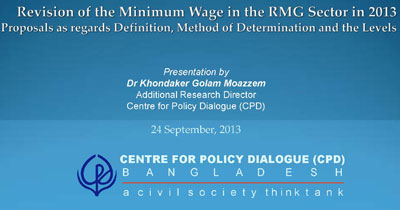The New York Times print edition carried an editorial on 13 November 2013 on the minimum RMG wage offers made by the government wage board, the workers’ demand of a higher pay and the owners’ argument of not bearing that expenditure. CPD recommendation of a basic diet for a family of three, costing about $67 (Tk 5,200), was cited to draw contrast between the offers and demands.
It may be noted that the CPD recommendations for a minimum RMG wage was determined by deploying three different methodologies for the entry level grade, of which the NY Times Editorial cited the minimum amount required for basic diet of three that a worker should get to stay just above the poverty line. Determined by the rest two methodologies in the study, Tk 8,200 ($ 106) was recommended as the minimum wage, proposing to gradually raise it with an initial amount of Tk 6,560 ($85); and Tk 17,800 ($230) was recommended as minimum wage considering an aspirational model diet which would include nutritious food and other essential non-food items.

Read the full Editorial
EDITORIAL
By THE EDITORIAL BOARD
Published: November 12, 2013
The government of Bangladesh is expected to soon announce an increase in the minimum wage for workers in the country’s clothing factories, which are big suppliers to Western retailers like Walmart and H&M. Its decision could improve the lives of millions of families that struggle to eke out an existence on as little as the equivalent of about $38 a month, the current minimum wage. A government-appointed board last week recommended to the Labor Ministry that the minimum wage be increased to about $68 a month. Factory owners, who wield tremendous political power in Bangladesh, have argued that they cannot afford the proposed increase and are pushing for a smaller one. But workers have said that they would not settle for less than $100 a month and have been protesting in the streets to press their case.
A basic diet that meets the needs of a family of three alone costs about $67 a month, according to a recent analysis by the Center for Policy Dialogue, a respected research organization based in Dhaka, the nation’s capital.
Here are some facts: The minimum wage was last increased in 2010. Since then, consumer prices have risen by 28 percent, according to government data. A basic diet that meets the needs of a family of three alone costs about $67 a month, according to a recent analysis by the Center for Policy Dialogue, a respected research organization based in Dhaka, the nation’s capital. At the same time, the garment industry, second to China’s in exports, has grown at a stunning rate in recent years and can afford to pay workers more. Bangladesh exported $19 billion in clothes last year, up more than 50 percent from two years earlier.
Government officials and industry executives say a big increase in the minimum wage might force some factories to close if they are not able to pass the costs to customers in the United States and Europe. That concern may be overblown. Several Western companies have made commitments to increase factory inspections and pay for safety improvements after a building collapse killed more than 1,100 garment workers near Dhaka earlier this year. Some businesses like H&M already support a higher minimum wage. Raising the minimum — and indexing it to inflation — would help workers and boost productivity by reducing the threat of strikes and protests.
A version of this editorial appears in print on November 13, 2013, on page A30 of the New York edition with the headline: A Living Wage in Bangladesh.



